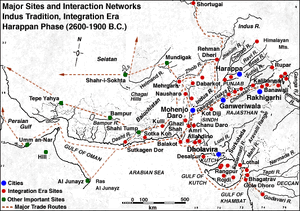Banawali
| Author:Laxman Burdak, IFS (R) |



Banawali (बनावली) is a village in Fatehabad tahsil and district in Haryana. Banawali is an archaeological site belonging to Indus Valley Civilization.
Location
Located 16 km from Fatehabad.
Jat Gotras
Population
The Banawali village has a population of 3688, of which 1970 are males while 1718 are females (as per Population Census 2011).[1]
History
Site of Indus Valley Civilization
Banawali is an archaeological site belonging to Indus Valley Civilization period in Fatehabad district, Haryana, India and is located about 120 km northeast of Kalibangan and 16 km from Fatehabad. Banawali, which is earlier called Vanavali, is on the left banks of dried up Sarasvati River.[2] Comparing to Kalibangan, which was a town established in lower middle valley of dried up Sarasvati River, Banawali was built over upper middle valley of Sarasvati River.[3]
It is a historically very important archaeological site which has provided very significant material for researchers to dig out the past of our rich historical and cultural growth.
Archaeological Survey of India has done excavation in this place revealed well constructed fort town of Harappan period overlaying an extensive proto urban settlement of pre-Harappan Period.[4] A defence wall was also found with a height of 4.5 m and thickness of 6 m which was traced up to a distance of 105 m.[5]
Houses, with rammed earthen floors, were well planned with rooms and toilets and houses were constructed on either sides of streets and lanes.[6]
The earlier bricks in Banawali had the Kalibangan ratio of 3:2:1, but later bricks had the ratio 4:2:1. One weight was found that weigh 87.855 grams, about 100 times 0.857 gram (a more common weight in Harappa). The wall surrounding this site was probably to face floods of Sarasvati River, and the wall collapsed due to water damage.[7] Marine shells were found at Banawali as well as at Harappa, Kalibangan, which are far away from sea shore and such findings indicate internal trade between the regions during early Indus period.[8] Seals were only found in lower town and not in citadel;several small stone weights and terrecotta plough model was also found.[9] Large number of female figurines are found at this site as well as at Mohanjodaro, Harappa.[10] A touchstone bearing gold streaks was found, which was probably used for testing the purity of gold (a technique that is still being used in this area).[11]
As is the practice, most of the finds have been reburied. However, a well of the Harappan era has been well preserved and stands as a testimony to the antiquity of the village.
The decline of urban life at Banawali and Kalibangan appears to be all of a sudden.[12]
Notable persons
External links
References
- ↑ http://www.census2011.co.in/data/village/60505-banawali-haryana.html
- ↑ Archaeological Survey of India. "Excavations - Banawali". website
- ↑ fatehabad.nic.in
- ↑ McIntosh, Jane R. (2008). The Ancient Indus Valley : New Perspectives. Santa Barbara, Calif.: ABC-CLIO. p. 229. ISBN 9781576079072.
- ↑ Archaeological Survey of India. "Excavations - Banawali". website
- ↑ Archaeological Survey of India. "Excavations - Banawali". website
- ↑ McIntosh, Jane R. (2008). The Ancient Indus Valley : New Perspectives. Santa Barbara, Calif.: ABC-CLIO. p. 229. ISBN 9781576079072.
- ↑ McIntosh, Jane R. (2008). The Ancient Indus Valley : New Perspectives. Santa Barbara, Calif.: ABC-CLIO. p. 229. ISBN 9781576079072.
- ↑ Singh, Upinder (2008). A History of Ancient and Early Medieval India : from the Stone Age to the 12th century. New Delhi: Pearson Education. pp. 152–153, 171, 179. ISBN 9788131711200.
- ↑ Singh, Upinder (2008). A History of Ancient and Early Medieval India : from the Stone Age to the 12th century. New Delhi: Pearson Education. pp. 152–153, 171, 179. ISBN 9788131711200.
- ↑ Lal, B.B. (2002). The Sarasvatī flows on : the continuity of Indian culture. New Delhi: Aryan Books International. p. 147. ISBN 9788173052026.
- ↑ Singh, Upinder (2008). A History of Ancient and Early Medieval India : from the Stone Age to the 12th century. New Delhi: Pearson Education. pp. 152–153, 171, 179. ISBN 9788131711200.

